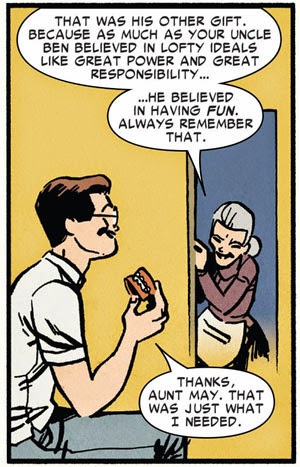R: Saga of the Sub-Mariner #7 (May 1989), art by Rich Buckler and Bob McLeod
(Click picture to Atlanti-size)
...Jerry, gazing at the girl in the far end of the row in which he sat, became more convinced than ever that the odd illusion of having been struck on the frontal bone by an atom bomb, experienced by him on his initial glimpse of her, had been to due to love at first sight. It happens that way sometimes. A's love for B, of for the matter of that, C's love for D, often requiring long months before it comes to the boil, can occasionally start functioning with the sudden abruptness of one of those explosions in a London street which slay six. There seems to be no fixed rule....and even never minder that there's another complication which initially failed to occur to Jerry:
He saw her now in the office of a registrar licenced to perform marriages, for he was sure that a girl like that would not want one of those ghastly choral weddings with bishops and assistant clergy horsing up all over the place. They would get it all fixed up in a couple of minutes, and later on they would sit together in their cozy little nest like two love birds on a perch. In the long winter evenings that would be, of course. In the summer they would be playing golf or enjoying a refreshing swim.Alas poor Jerry? Heck no. Lucky Jerry to be a character in a Wodehouse romance, as his engagement to social-climbing shrewish Vera Upshaw is casually broken (by her) with little or no consequence, freeing Jerry up to woo Jane. Ain't love grand? In such a way I someday hope to woo Miss Keira Knightley.
It was as his mind's eye was probing even more deeply into their domestic life that there came to him the realization that there was an obstacle, and a rather serious one, in the way of the bliss he was contemplating. He had suddenly remembered, what for the moment had slipped his mind, that he was engaged to be married to someone else.
'...You are familiar with the exploits of Sherlock Holmes?'That is, of course, because Crispin is, unlike the cerulean miniature, is well in the red:
'Know them by heart, but which of them would be any use to us? Would it be the Adventure of the Five Orange Pips? Are you planning to intimidate Mrs. Clayborne by sending her five orange pips, with a message telling her to put the miniature on the sun dial?'
'That had not occurred to me.'
'It might work. It would depend, of course, on whether she's allergic to orange pips. Many people aren't.'
'My plan is based not so much on a story as on something Holmes said in one of the stories. He said, if you recall, that when a house is on fire, everyone's impulse is to carry out from the flames the thing most precious to them; in Mrs. Clayborne's case, I think we may assume, the miniature. That seems to me a correct statement of human psychology.'
Jerry, having no mustache to finger, fingered his chin.
'Let's get this straight. For the moment I'm a little fogged. Are you proposing to set fire to Mellingham Hall?'
Crispin could not repress a wistful sigh. The picture of a heavily insured Mellingham Hall in flames was a very attractive one.
And indeed there was a certain resemblance between Crispin and such a cadaver, for the passage of time had done nothing to diminish the horror of the task before him. He was also experiencing pains of remorse for the past. 'Oh, what a tangled web we weave,' he was saying to himself, 'when we touch a brother for two hundred and three pounds six and fourpence and then go and lose a hundred of it on a horse that comes in second.'Never fear, dear Reader: everyone has a happy ending: finances gained, loves blossomed, miniatures restored. It's a clever book: like an episode of Columbo, the fun is not in finding out whodunit but in seeing how the mystery is unraveled. While Jerry and Jill are pleasant but somewhat nondescript hero and heroine, Chippendale, the butler who calls his master "cocky" and "chum" steals much of the show, and is even the center of attention in the novel's closing moments. In 1970 Wodehouse's career was winding down, and while The Girl in Blue isn't one of his top books, it has a pleasant spiraling plot and amicable characters, and the brief mention of a twin miniature of a Girl in Green suggests maybe we might have seen a sequel and a return to Mellingham Hall someday. Alas, it was never to be, but we can dream, can't we? We can dream...
